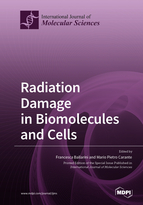Radiation Damage in Biomolecules and Cells
A special issue of International Journal of Molecular Sciences (ISSN 1422-0067). This special issue belongs to the section "Molecular Biophysics".
Deadline for manuscript submissions: closed (31 July 2020) | Viewed by 97235
Special Issue Editors
2. Istituto Nazionale di Fisica Nucleare – Sezione di Pavia, Pavia, Italy
Interests: (modelling) the action of ionizing radiation in biological targets, with focus on DNA/chromosome damage and cell death
Special Issues, Collections and Topics in MDPI journals
2. Physics Department, University of Pavia, Pavia, Italy
Interests: ionizing radiation; radiobiology; hadron therapy; nuclear physics
Special Issues, Collections and Topics in MDPI journals
Special Issue Information
Dear Colleagues,
Ionizing radiation is widely used in medicine, both as a diagnostic tool and as a therapeutic agent. Furthermore, several exposure scenarios (e.g., occupational exposure, radon, space radiation) raise radiation protection issues. It is therefore mandatory for the scientific community to continuously update and improve the knowledge of the mechanisms governing the induction of radiation effects in biological targets and to apply the acquired information to optimize the medical use of radiation as well as the protecting strategies.
For instance, although the DNA is widely recognized as the main target of radiation, the features of the critical DNA damage type(s) leading to cell death or cell conversion to malignancy are still unclear; in addition, the role played by other targets (which may be involved in bystander effects and other low-dose phenomena) deserves further investigation. Among the many possible medical applications, different aspects of hadron therapy should be further addressed, including a more and more accurate RBE evaluation and the use of alternative sources like He and O ions. Such investigations can be carried out both experimentally, by means of in vitro and in vivo studies, and theoretically, by biophysical models and simulation codes.
This Special Issue on “Radiation damage in biomolecules and cells” is open to researchers working (both experimentally and theoretically) on the effects of ionizing radiation at the molecular and cellular levels. We welcome papers on the different types of DNA/chromosome/cell damage, addressing the underlying mechanisms and/or the dependence on dose, dose–rate, radiation quality, cell type, etc., as well as the possible implications for radiotherapy and radiation protection.
Dr. Francesca Ballarini
Dr. Mario Pietro Carante
Guest Editors
Manuscript Submission Information
Manuscripts should be submitted online at www.mdpi.com by registering and logging in to this website. Once you are registered, click here to go to the submission form. Manuscripts can be submitted until the deadline. All submissions that pass pre-check are peer-reviewed. Accepted papers will be published continuously in the journal (as soon as accepted) and will be listed together on the special issue website. Research articles, review articles as well as short communications are invited. For planned papers, a title and short abstract (about 100 words) can be sent to the Editorial Office for announcement on this website.
Submitted manuscripts should not have been published previously, nor be under consideration for publication elsewhere (except conference proceedings papers). All manuscripts are thoroughly refereed through a single-blind peer-review process. A guide for authors and other relevant information for submission of manuscripts is available on the Instructions for Authors page. International Journal of Molecular Sciences is an international peer-reviewed open access semimonthly journal published by MDPI.
Please visit the Instructions for Authors page before submitting a manuscript. There is an Article Processing Charge (APC) for publication in this open access journal. For details about the APC please see here. Submitted papers should be well formatted and use good English. Authors may use MDPI's English editing service prior to publication or during author revisions.
Keywords
- Ionizing radiation
- DNA damage
- Chromosome aberrations
- Cell death
- Hadron therapy
- Radiation protection
- Biophysical models
- Computational radiobiology







